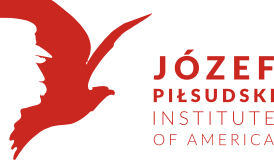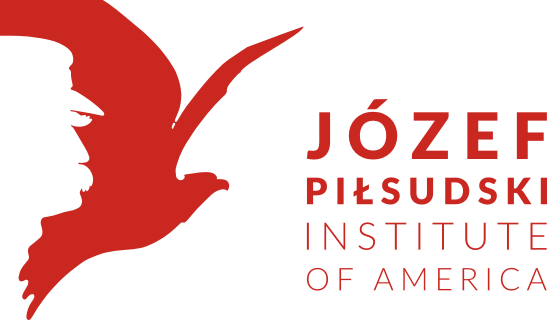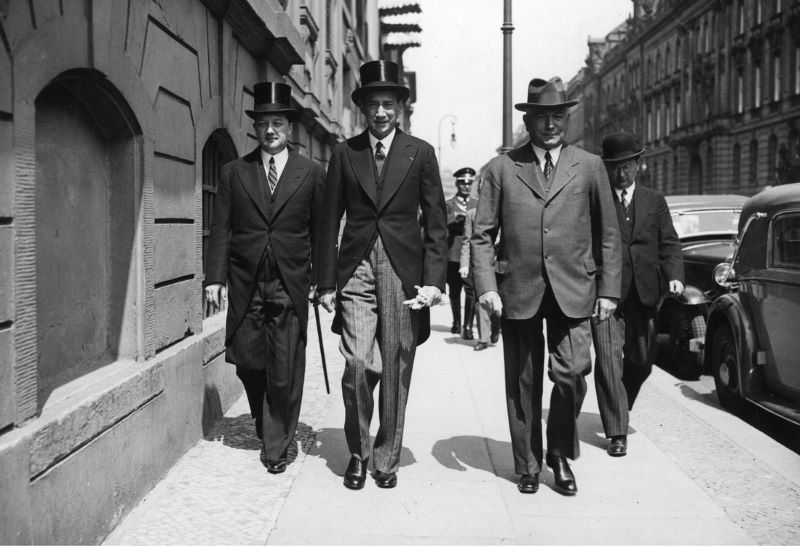 J.Beck's official visit in Berlin, July 1935, from the left: ambassador J.Lipski, Polish minister of foreign affars Jozef Beck and his German counterpart K. von Neurath. Source - National Digital Archives of Poland
J.Beck's official visit in Berlin, July 1935, from the left: ambassador J.Lipski, Polish minister of foreign affars Jozef Beck and his German counterpart K. von Neurath. Source - National Digital Archives of Poland
 President Mościcki in Nowy Targ, Poland in 1929
President Mościcki in Nowy Targ, Poland in 1929
I really like black and white photographs, and those from the time period of the Second Polish Republic have special charm. It was undoubtedly a very interesting, though not easy, period in the history of Poland. The process of merging the multinational and multireligious parts of the Republic, which until recently were part of three different states, was extremely challenging. Economically, the country was backward after many years of Partitions, three different currencies were used, and the existence of the state at the beginning of the 1920s was very fragile. It was a period of dramatic struggle for the shape of Poland's borders: the heroic defense of Lviv and the fights for Eastern Galicia, conflict with the Czechs over Zaolzie, the time of the Silesian uprisings, the Greater Poland Uprising, and the Polish-Bolshevik war of 1919-1921.
Rebuilding the state was a long and difficult process. Undoubtedly, despite the enormous difficulties that Poland was facing at that time, a lot was achieved. The extraordinary enthusiasm of both: intellectual elites and ordinary people, helped in the transformation process. In the 1920s, the Polish government introduced a monetary reform. The reform saved Poland from hyperinflation and a new currency - the Polish zloty was introduced. A number of new universities were opened; including, University of Science and Technology in Krakow, University of Poznań, and Stefan Batory's University in Vilnius was re-opened.
 Letters wrote by polish soldiers to Stefania Bardzilowska during the World War II
Letters wrote by polish soldiers to Stefania Bardzilowska during the World War II
The art of letter writing is becoming forgotten, and although everyone likes to receive them, letters are quickly being replaced by other forms of communication. Instead of writing a letter, we prefer to send a text message or email to the other person, and we can count on an immediate response, even if they are on the other side of the world. In the past when there were no modern inventions, letters were very important. They were not only a means of conveying information, under special circumstances, such as travel, war or exile, they became particularly meaningful.
Indeed, letters lifted the spirits of soldiers fighting in the Polish Army in the West, full of bitterness, sadness, and longing, usually exchanged between completely strangers, were often the only form of communication with the outside world. Polish soldiers, prisoners of war, wrote letters asking for help, and in response, received food packages for a long time through International Red Cross.
Many letters preserved in our collection, were written by Stefania Bardziłowska to Polish soldiers in German's captivity, as well as to soldiers of the Polish Armed Forces fighting in the West, who could not maintain contact with their families. To keep morale up, a program of letters exchange with regular civilians from Polonia was introduced. Many such letters were addressed to Stefania Bardziłowska, a social activist living in Chicago, deeply involved in providing aid to polish soldiers in the West. Ms. Bardziłowska, organized shipments of food packages and sent supporting letters for the soldiers. Although, in accordance to the Geneva Convention, correspondence with prisoners of war was restricted only to close relatives and family members, Bardziłowska managed to obtain a number of addresses of Polish prisoners of war from the International Red Cross. For quite some time, German and American censorship kept the food packages program running.
A few months ago, the Institute received an e-mail from a historical reconstruction group from Poland, in connection with the 80th anniversary of the defense of Tobruk (located in Libya, near the border with Egypt). The group wanted to see the photos of the Independent Carpathian Rifle Brigade's soldiers. We keep many photos of the Independent Brigade in our archives, thus the email was an impulse for us to digitize another part of our collection. This time, we managed to prepare an unique collection, a great source of the information about the WWII battles in North Africa. 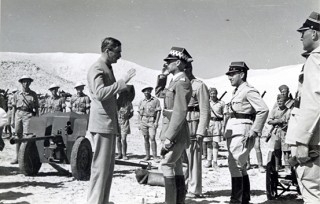 Anthony Eden, British Foreign Secretary with the soldiers of the Brigade, October 1941
Anthony Eden, British Foreign Secretary with the soldiers of the Brigade, October 1941
Preparing the photos for an online presentation is a tedious process, first, we have to research the collection diligently, then make a selection of photos, next the photos have to be scanned, annotated and finally posted online. After a few weeks of work, the project was successfully completed. We have posted photos showing the soldiers' training, the construction of the Latrun camp, fortifications near Tobruk, exercises and combat operations of the Independent Carpathian Rifle Brigade's soldiers. In the black-and-white photos we see soldiers' difficult life in the desert, all the sacrifices; fight in unfavorable weather conditions, under the constant threat from the enemy.
The Pilsudski Institute of America is named after none other than Marshal Jozef Pilsudski, whose leadership and efforts largely contributed to Poland’s independence. 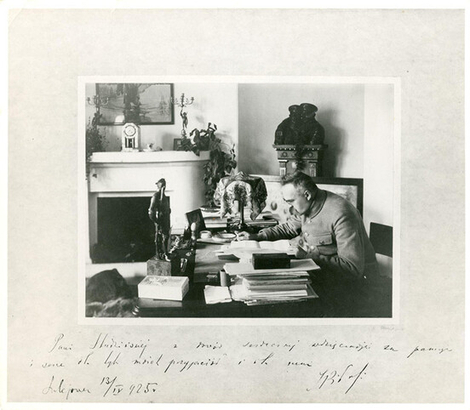 Marshal Pilsudski at Belvedere palace 1930r.
Marshal Pilsudski at Belvedere palace 1930r.
Our archives contain many photos, letters and documents that illustrate Pilsudski’s character, personality and life. As for any historical figure, the interpretation of such records allows us to better assert an individual’s role in history. The following photographic collection depicts Pilsudski with soldiers, family and significant historical figures living during his time period. There are likewise many portraits and individual pictures that convey his character and physical appearance.
Born in 1867 Zułów, then under the Russian Empire, Jozef Pilsudski was born into a patriotic family where Polish literature, history and culture were daily present. In 1887 he was exiled to Siberia as a result of affiliation with a Russian revolutionary movement. Following his return, he became actively involved in the Polish Socialist Party. At the start of World War I, Pilsudski formed the First Cadre Company, arguably becoming Poland’s most important military leader. After World War I, Pilsudski served first as Chief of State, then Marshal and twice as a prime minister of Poland. Informally, de facto, he was a leader of the Second Polish Republic.
The collection of Marshal Pilsudski's photos.
Marshal J. Piłsudski was an independence fighter, a statesman, the "father" of reborn Poland in 1918. The charismatic leader, an experienced, sometimes even ruthless politician, in private life was a warm and affectionate person, appreciating family life. When he retired from political life in 1923, the manor house in Sulejówek at the outskirts of Warsaw, became his favourite place. The Marshal loved this house, called "Milusin". In Sulejowek, he enjoyed the family life, the company of his wife Aleksandra and daughters: Wanda and Jadwiga. He liked taking strolls in the garden and watching his favorite pasque-flowers grow.
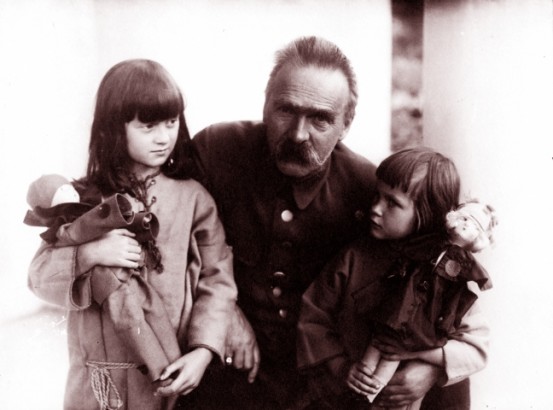 J. Pilsudski with his daughters: Wanda i Jadwiga.
J. Pilsudski with his daughters: Wanda i Jadwiga.
In "Milusin", the Marshal was working on his book "The reminiscence of Gabriel Narutowicz" and "The Year 1920". Although Piłsudski officially withdrew from political life, the most important state decisions were still made in Sulejówek. In 1926, after the May Coup, the Piłsudski family had moved to Warsaw and settled in Belweder Palace. However, "Milusin" remained their family residence.
- Karolina Obrycki
Edward Rydz-Smigły an Artist
Few are aware that Edward Rydz-Smigly, the last Marshal of pre-war Poland, was also an artist. During his internment in Romania, following the outbreak of World War II, Rydz-Smigly created eight paintings that are now part of the Pilsudski Institute's collection. The paintings, generously donated by Mr. Stanisław Krzeczkowski, are a testament to the multifaceted nature of this complex historical figure.
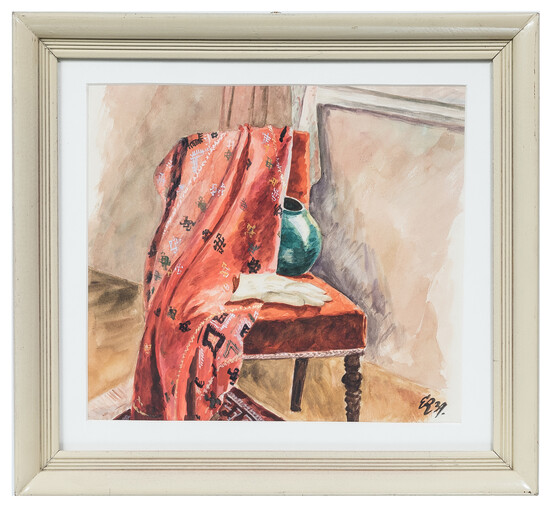
One of the paintings, a vibrant watercolor still life - "Martwa natura," captures the eye with its patterned and exotic fabric, a green vase resting on a chair, and a light glove negligently left on the same chair. The frames of other artworks, visible in the background, suggest that Rydz-Smigly painted his own artistic studio. Interestingly, artistic work proved to be the most effective psychological therapy for Rydz-Smigly during his internment, providing him with a sense of creative release in a time of turmoil.
- Captain Tadeusz Terlecki
- Polish secret intelligence unit in New York during the WWII
- The founders of the Pilsudski Institute
- Marshal Pilsudski's Collection
- Gen. Ander's Army
- The story of Capitan William Gawroński
- Pre-war architectural photography collection
- General Tadeusz Rozwadowski Files Available Online
- “Adjutancy - Commander-in-Chief” archive fully digitized


